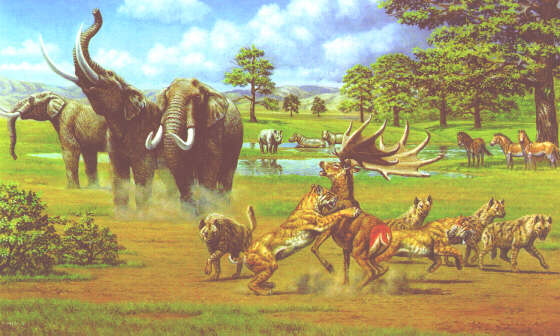 |
 |
 |
 |
 |
Produced
by the Population Genetics and Evolution class, Furman University |
||||
 |
 |
 |
 |
 |
Produced
by the Population Genetics and Evolution class, Furman University |
||||
 |
The
Neogene: Borophagus |
 |
||
| Borophagus
were vicious organisms that closely resembled canids (dogs) that we see
today. Fossil records indicate that they grew to almost a meter in length
by the time they matured into adults (AA 2010). Scientists believe that
they lived and hunted in packs, which would allow for greater individual
protection and reproductive success (Eaton 2001). This pack-dwelling habit
could be significant evolutionarily, because it correlates with communal
lifestyle that many mammals today demonstrate, including most members
of the dog family. Borophagus were probably carnivores that mainly
scavenged for remains of other dead animals because of their relatively
small body size (AA 2010). The most distinguishing feature that Borophagus
had was their large canine teeth that allowed them to tear meat and flesh
off of their prey. Evidence from their skulls indicate that Borophagus
could close their jaws with enough force to snap bones because their shortened
lower jaws had a large amount of muscle attachment; they also had specialized
teeth which allowed them to masticate and process food with greater efficiency
(NPS 1994). Due to shared traits, Borophagus could be the early
ancestors of today’s canids.
Page by Pete Calomiris |
 |
| Borophagus. Picture From: The National Park Service. | |
|
Absolute Astronomy. 1999. Borophagus. AbsoluteAstronomy.com. Accessed April 2010. Eaton J. 2001. Mastodons in our midst. BayNature.org. Accessed April 2010. National Park Service. 1994. Hyena-like Dogs. The Fossil Record. Accessed April 2010. |